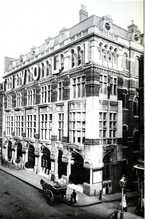EN
history of the theatresupplementtechnical dataHistoric equipmentTivoli Music Hall
Charles John Phipps
alias Tivoli Theatre of Varieties65-70 Strand, | |
| show on the map |
Important events
(detail)24.5.1890 | opening
It opened on 24th May 1890 with 1,500 seats and was designed by architect Walter Emden in an Oriental style.
People
Charles John Phipps |main architect
History
Additional information
No information has yet been entered
Add information








